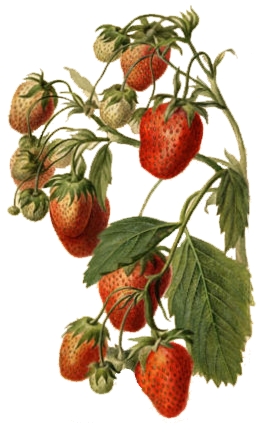Breeding of strawberries
Breeding of strawberries
The breeding of strawberries involves the selective cultivation of strawberry plants to produce new varieties with desirable traits. This process includes the selection of parent plants, controlled pollination, and the evaluation of offspring for traits such as fruit size, flavor, disease resistance, and yield.
History[edit | edit source]
The modern cultivated strawberry, Fragaria × ananassa, originated in Europe in the 18th century through the hybridization of two wild species: Fragaria virginiana from North America and Fragaria chiloensis from South America. Early breeders focused on improving fruit size and flavor, leading to the development of many of the varieties grown today.
Breeding Techniques[edit | edit source]
Strawberry breeding employs several techniques to achieve desired traits:
Selection[edit | edit source]
Selection involves choosing parent plants with favorable characteristics. These plants are then cross-pollinated to produce offspring that may inherit the desired traits.
Hybridization[edit | edit source]
Hybridization is the process of crossing different strawberry varieties to combine their traits. This can be done through controlled pollination, where pollen from one plant is transferred to the flower of another.
Mutation Breeding[edit | edit source]
Mutation breeding involves exposing strawberry plants to chemicals or radiation to induce genetic mutations. These mutations can sometimes result in beneficial traits that can be selected for further breeding.
Genetic Engineering[edit | edit source]
Genetic engineering is a more recent technique that involves directly modifying the DNA of strawberry plants to introduce new traits. This method is still under research and development and is subject to regulatory approval.
Traits of Interest[edit | edit source]
Breeders focus on several key traits when developing new strawberry varieties:
- Fruit size: Larger fruits are often preferred for commercial production.
- Flavor: Sweetness and aroma are important for consumer preference.
- Disease resistance: Resistance to common diseases like powdery mildew and gray mold is crucial for reducing crop losses.
- Yield: High-yielding varieties are essential for commercial viability.
- Shelf life: Improved shelf life is important for reducing post-harvest losses.
Challenges[edit | edit source]
Strawberry breeding faces several challenges, including the plant's complex genetics and the long time required to develop new varieties. Additionally, environmental factors such as climate change can impact the success of breeding programs.
Future Directions[edit | edit source]
Future directions in strawberry breeding include the use of advanced genetic techniques such as CRISPR for precise gene editing, as well as the development of varieties that can thrive in a changing climate. Researchers are also exploring the potential of marker-assisted selection to speed up the breeding process.
Related Pages[edit | edit source]
Search WikiMD
Ad.Tired of being Overweight? Try W8MD's physician weight loss program.
Semaglutide (Ozempic / Wegovy and Tirzepatide (Mounjaro / Zepbound) available.
Advertise on WikiMD
|
WikiMD's Wellness Encyclopedia |
| Let Food Be Thy Medicine Medicine Thy Food - Hippocrates |
Translate this page: - East Asian
中文,
日本,
한국어,
South Asian
हिन्दी,
தமிழ்,
తెలుగు,
Urdu,
ಕನ್ನಡ,
Southeast Asian
Indonesian,
Vietnamese,
Thai,
မြန်မာဘာသာ,
বাংলা
European
español,
Deutsch,
français,
Greek,
português do Brasil,
polski,
română,
русский,
Nederlands,
norsk,
svenska,
suomi,
Italian
Middle Eastern & African
عربى,
Turkish,
Persian,
Hebrew,
Afrikaans,
isiZulu,
Kiswahili,
Other
Bulgarian,
Hungarian,
Czech,
Swedish,
മലയാളം,
मराठी,
ਪੰਜਾਬੀ,
ગુજરાતી,
Portuguese,
Ukrainian
Medical Disclaimer: WikiMD is not a substitute for professional medical advice. The information on WikiMD is provided as an information resource only, may be incorrect, outdated or misleading, and is not to be used or relied on for any diagnostic or treatment purposes. Please consult your health care provider before making any healthcare decisions or for guidance about a specific medical condition. WikiMD expressly disclaims responsibility, and shall have no liability, for any damages, loss, injury, or liability whatsoever suffered as a result of your reliance on the information contained in this site. By visiting this site you agree to the foregoing terms and conditions, which may from time to time be changed or supplemented by WikiMD. If you do not agree to the foregoing terms and conditions, you should not enter or use this site. See full disclaimer.
Credits:Most images are courtesy of Wikimedia commons, and templates Wikipedia, licensed under CC BY SA or similar.
Contributors: Prab R. Tumpati, MD


